Site pages
Current course
Participants
General
Module 1. Moisture content and its determination.
Module 2. EMC
Module 3. Drying Theory and Mechanism of drying
Module 4. Air pressure within the grain bed, Shred...
Module 6. Study of different types of dryers- perf...
Module 5. Different methods of drying including pu...
Module 7. Study of drying and dehydration of agric...
Module 8. Types and causes of spoilage in storage.
Module 9. Storage of perishable products, function...
Module 10. Calculation of refrigeration load.
Module 11. Conditions for modified atmospheric sto...
Module 12. Storage of grains: destructive agents, ...
Module 13. Storage of cereal grains and their prod...
Module 14. Storage condition for various fruits an...
Module 15. Economics aspect of storage
Lesson- 33 Natural ventilation/Aeration, Mechanical Ventilation/Aeration and Artificial Drying of Grains
Ventilation or Aeration is the process of moving the air through stored grain mass at considerably lower air flow rates to maintain the quality. Ventilation provides three major benefits the stored gain mass:
1. It cools the grain and slows down insect activity.
2. By cooling the grain, aeration prolongs the effectiveness of pesticides.
3. It can provide an appreciable drying function.
There are mainly two types of ventilation systems, namely a) Natural ventilation and b) Mechanical ventilation
33.1 Natural Ventilation
Natural ventilation is the process of supplying and removing air through an indoor space without using mechanical systems and is shown in fig. 33.1. It refers to the flow of external air to an indoor space as a result of pressure or temperature differences. There are two types of natural ventilation occurring in buildings: wind driven ventilation and buoyancy-driven ventilation. While wind is the main mechanism of wind driven ventilation, buoyancy-driven ventilation occurs as a result of the directional buoyancy force that results from temperature differences between the interior and exterior
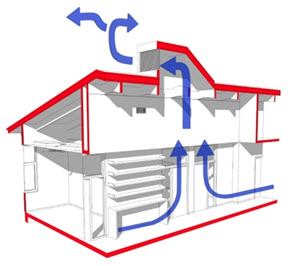
Fig.33.1 Natural Ventilation
The following Fig. 33.2 shows the example of natural ventilation structures for the storage of grains in bags.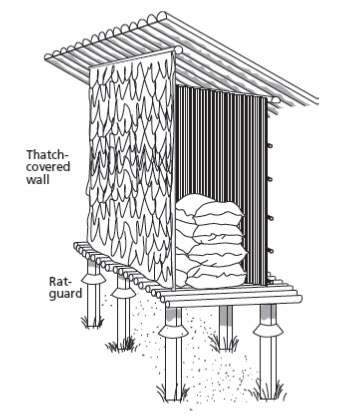
Fig.33.2 Natural Ventilated for storing grain in bags
The static pressure of air is the pressure in a free-flowing air stream and is depicted by isobars in weather maps. Differences in static pressure arise from global and microclimate thermal phenomena and create the air flow we call wind. Dynamic pressure is the pressure exerted when the wind comes into contact with an object such as a hill or a building and it described by the following equation

where ,
q = dynamic pressure, Pa
p = fluid (air) density, kg/m3
v = fluid velocity, m/s.
The impact of wind on a building affects the ventilation and infiltration rates through it and the associated heat losses or heat gains. Wind speed increases with height and is lower towards the ground due to frictional drag. The impact of wind on the building form creates areas of positive pressure on the windward side of a building and negative pressure on the leeward and sides of the building. Thus building shape and local wind patterns are crucial in creating the wind pressures that will drive air flow through its apertures. In practical terms wind pressure will vary considerably creating complex air flows and turbulence by its interaction with elements of the natural environment (trees, hills) and urban context (buildings, structures). Vernacular and traditional buildings in different climatic regions rely heavily on natural ventilation for maintaining thermal comfort conditions in the enclosed spaces.
Building Design Guidelines for the Natural Ventilation Structures
The following design guidelines are normally practiced from the Whole Building Design Guide, a program of the National Institute of Building Sciences:
Maximize wind-induced ventilation by sitting the ridge of a building perpendicular to the summer winds
Widths of naturally ventilated zone should be narrow {max 13.7 m (45 feet)}
Each room should have two separate supply and exhaust openings. Locate exhaust high above inlet to maximize stack effect. Orient windows across the room and offset from each other to maximize mixing within the room while minimizing the obstructions to airflow within the room.
Window openings should be operable by the occupants
Consider the use of clerestories or vented skylights.
33.2 Mechanical Ventilation
Mechanical ventilation is the process of supplying and removing air by using mechanical systems.

Fig.33.3 Mechanical Ventilation with Duct System for Grain Drying
Mechanical Ventilation systems can be installed in both horizontal and vertical storages. The following set of basic design parameters are found suitable for cooling of dry grains by mechanical ventilation.
Air flow rate: Silos 0.8 litre/second/tonne
Sheds 1.6 litre/second/tonne
Maximum duct velocity: 10 m/ s
Maximum entry velocity of air into grain: 0.15 m/ s
The most common air flow rates for aerating paddy range from 0.07-0.28 m3/minute/tonne of paddy. The above air flow rates for aeration are only a fraction of the air volume needed to dry grains. From above parameters, fan output, duct size and duct surface area can be determined.
Air can be pulled or pushed through the grain in storage. The air can be moved from the top to bottom or from the bottom to the top of the bin. In the tropical climates, aeration should be done from bottom to top because any air trapped under the roof of a storage structure is usually at high temperature. This high temperature air can be forced out easily from the top. The cooler air from bottom also cools the warmer grain stored in bin (Fig.33.3).
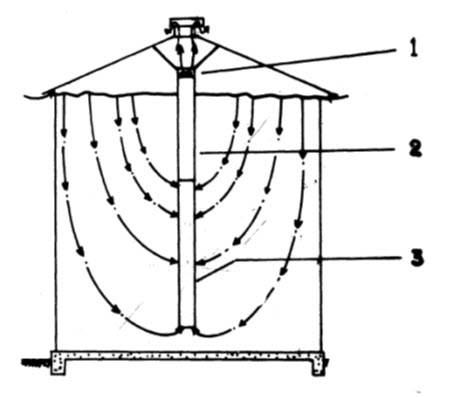
- Fan 2. Solid duct 3. Perforated section
Fig.33.4 Central ventilation/aeration system in vertical silo
Axial fans are normally used for shed aeration. Non-overloading centrifugal fans should be used for vertical storages because of the higher pressure requirements (Fig.33.4). With overloading fan, it is recommended that a manually adjustable throttle valve should be used in the inlet duct to cut back the airflow while aerating partly filled silos. The principal parts of an aeration system are, (1) fans to move the air and (2) ducts for carrying air from the fans to storage system.
Various configurations of ducting can be used for air distribution inside the grain mass. Ventilation systems for silos are, usually; (1) central vertical system (Fig. 33.4), (2) floor ducts (Fig. 33.5) and (3) perforated floors (Fig. 33.6).
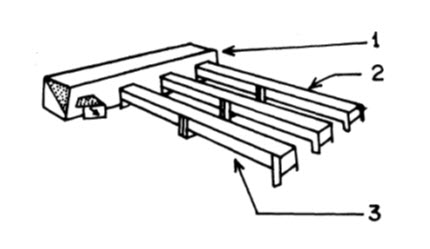
Fig. 33.5 Floor ducts for aeration
1. main duct 2. transferable lateral ducts 3. interspace on floor
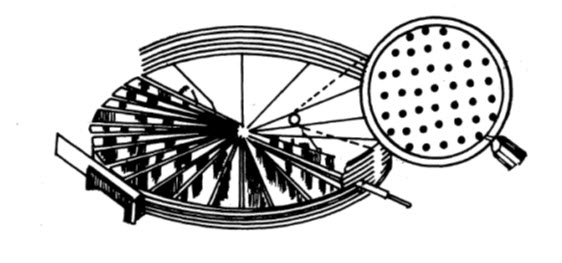
Fig. 33.6 Perforated floor cross-section for aeration
In a vertical duct system the top part of the central duct is solid and the lower half section is perforated. A fan at the top of the duct pulls the air through the grain and perforations. The sucked air is blown out of the bin by the fan. When on-floor ducting is used, it is often important to allow for its removal to facilitate floor sweeping. For this reason, full round ducting is usually used in sheds where grain loads are moderate. Both longitudinal and cross-floor ducting can be used in sheds. Generally ducting is made from galvanized steel sheet with 2.5 mm perforations at 6 mm centers.
Ducting in silos is normally exposed to considerably higher grain pressures. In-floor ducting requires the use of flat perforated sheet. Cost of such system is significantly higher because of requirement of a structural frame below the perforated sheet for its support. An alternative is perimeter ducting formed from quarter round corrugated ducting.
Perforated ducts may be circular, semicircular, rectangular or inverted V-shaped. The required cross-section area of a duct may be determined by the following expression.
33.3 Artificial Drying
Unlike sun drying, artificial drying has the advantage that suitable drying conditions can be set, and that drying can be carried out any time of day or night. Use of artificial drying may also reduce the labor costs of drying, especially if some form of artificial turning or stirring of grain is practiced, as in the case of re-circulating dryers. In general, artificially dried grain will produce better quality of grain as compared to sun drying. Artificial drying will lead to more uniform drying of grain and higher milling yield and head recovery. Grain re-circulation allows for uniformly dried grain and automatic drying air temperature control will reduce over-heating or over-drying.
Two common types of grain dryers in Asia are the flatbed dryer and the re-circulating batch dryer. They are both batch-fed dryers meaning that a certain quantity of grain is loaded and dried before the dryer is unloaded and a new batch can be dried.
33.3.1 Flatbed type dryer
Flatbed dryers have a very simple design. Grain is laid out on a perforated screen, and dried by forcing air from below as shown in fig. 33.7. The air fan that provides the drying air is usually a simple axial flow fan that is powered by a diesel or electric motor. Drying heat is provided by a kerosene burner or biomass fueled stove. The capacity of the dryer varies from one ton to eight tons. Generally the drying floor is flat although dryers with reclining sections (to facilitate unloading) or vibrating sections (to facilitate stirring) exist as well. The height of the layer is usually 40 cm. The most common smaller dryers have a capacity of one to three tons per day with drying times of six to twelve hours. For drying of paddy in tropical areas, an air temperature of 40-45 ºC is normally used with a heater capable of raising the air temperature 10-15 ºC above ambient. An air velocity and typical fan power requirements are 0.15-0.25 m/s and 1.5-2.5 kW /ton respectively for paddy crop. The efficiency of these dryers is improved by stirring the grain during drying (Fig. 33.7).

Fig. 33.7 Flatbed type of dryer
33.3.2 Re-circulating batch dryers
Re-circulating batch dryers have been used for a long time in Japan, and are now common in many Asian countries. This dryer consists of two centric circular cylinders made of perforated (2 mm) mild steel sheet of 20 gauge. The two cylinders are set 15 to 20 cm apart. These two cylinders are supported on four channels sections. The whole frame can be supported by a suitable foundation or may be bolted to a frame made of channel section. A bucket elevator of suitable capacity is used to feed and re-circulate the grain into dryer. A centrifugal blower blows the hot air into the inner cylinder which acts as a plenum. The hot air from the plenum passes through the grain moving downward by gravity and comes out of another perforated cylinder. A torch burner is employed to supply the necessary heat, with kerosene oil as fuel. The designs of dryer for ½, 1 and 2 tonnes holding capacity are available. The Re-circulating batch dryers of 2 tonnes holding capacity is shown in Fig. 33.8.
The grain is fed to the top of the inside cylinder. While descending through the annular space from the feed end to the discharge end by gravity, the grain comes in contact with a cross flow of hot air, supplied inside the perforated inner cylinder. The exhaust air comes out through the perforations of the outer cylinder and the grain is discharged through the outlet of the hopper. The feed rate of the grain is controlled by closing or opening the gate provided with the outlet pipe of discharge hopper. The grain is re-circulated till it is dried to the desired moisture level.
The main advantages of the re-circulating dryer are
Its size and shape occupies only very limited floor space therefore it can easily be place inside a grain store or warehouse
Price is reasonable.
Simple design amongst all flow type dryers.
Easy to operate.
It can be used on the farm and rice mill as well.
Operating cost is low with husk fired furnace.
However, the loading, unloading and circulation of grain create dust which needs to be collected in a collection system. In addition, it is recommended to pre-clean the grain prior to loading and drying. As with the flatbed dryer, re-circulating dryers come in a variety of capacities, from 2 tons (for seed production stations) up to 20 tons (for cooperative drying stations).
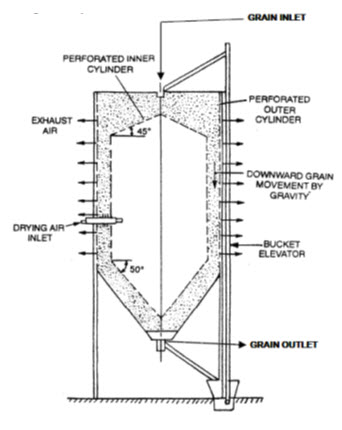
General precautions in using artificial grain dryers
Before loading the dryer, clean the grain by removing fines and green, immature grains . Fines reduce the air flow through rice causing increased drying time and wet spots.
In the dryer, do not mix dry rice with wet rice. The drying air gains moisture as it passes through the dryer and may cause the dry rice to fissure.
Reference:
-
Website: http://www.ctu.edu.vn/institutes/mdi/extension/iot/rice-product/ppfm/
Drying_and_Storage/Drying_lesson07.htm
-
Drying Ear Corn by Mechanical Ventilation; Miscellaneous Publication No. 919, U.S. Department of Agriculture.
-
A Text Book Unit Operations of Agricultural Processing by K.M Sahay and K.K.Singh